The reverse cable fly, also known as the Cable rear delt fly, is an exercise that increases deltoid muscle definition and strength.
The standing reverse cable fly exercise targets your upper back muscles and shoulder muscles, particularly the posterior deltoids, or rear deltoids, on the backside of your shoulders.
A well-developed rear deltoid not only enhances your physique, but also improves your shoulder functionality for various activities, including weightlifting, sports, and even daily tasks.
However, performing this exercise can be tricky, especially if you’re not familiar with the correct form. That’s where this ultimate guide comes in.
In this article, we explore the following.
- What is the standing cable reverse fly?
- Anatomy and functions of the deltoid
- Benefits of the Cable Reverse fly.
- What muscles does it work
- How to perform it correctly?
- Best reverse cable fly variations.
- Best Alternate of it
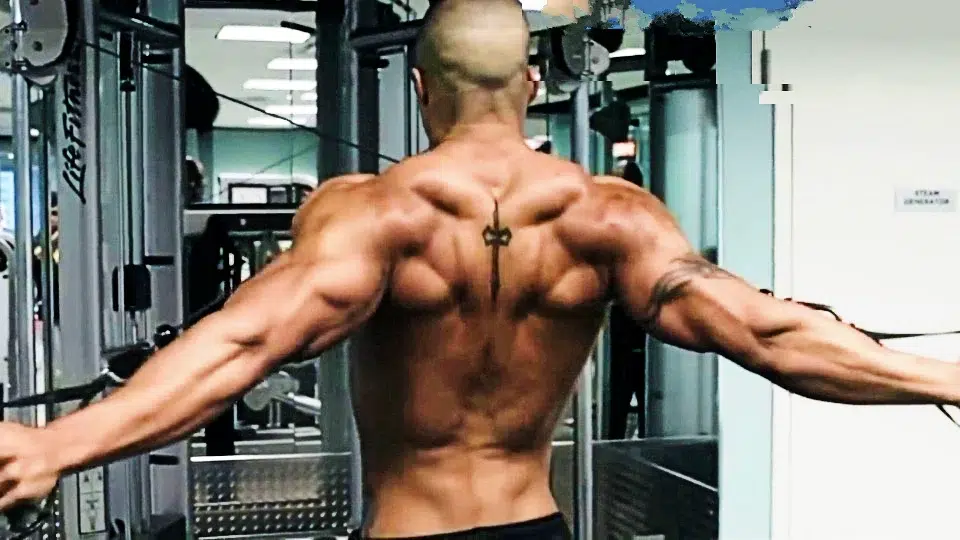
- What Is The Cable Reverse Fly?
- Reverse Cable Fly Muscle Worked
- Benefits Of Reverse Cable Fly
- How To Do Standing Cable Reverse Fly
- Tips And Form For Reverse Cable Fly
- Set, Reps And Frequency
- Beginner
- Intermediate
- Advanced
- Reverse Cable Fly Variations
- 1. Bent Over Reverse Cable Fly
- 2. Seated Reverse Cable Fly
- 3. Single Arm Standing Reverse Cable Fly
- Cable Rear Delt Fly Alternatives
- 1. Bent Over Dumbbell Lateral Raise
- 2. Dumbbell Rear Delt Row
- 3. Seated Rear Delt Fly Machine
- 4. Face Pull
- FAQ
- Is The Cable Rear Delt Fly Good?
- What Muscle Does The Revers Fly Work?
- Is it necessary to use heavy weights for the reverse cable fly?
- Is reverse fly push or pull?
- Why is reverse fly so hard?
- Takeaways
- Rear Delt Cable Exercises for Bigger and Stronger Shoulder
What Is The Cable Reverse Fly?
Cable reverse fly is an isolation movement that trains the posterior muscles. The term ‘isolation movement’ can be misleading. To clarify, it is more accurately described as a single-joint exercise in order to avoid confusion.
The standing cable reverse fly is an effective exercise that targets the upper back and shoulder muscles mainly rear delt, traps, rhomboids.
This exercise uses a cable machine with a handle attachment to make a fly-like movement. The handles are pulled away from the body using the muscles in the back of the body.
During the standing reverse cable fly, the movement is primarily felt at the shoulder. Imagine spreading your arms wide as if you were giving someone a big hug, but in reverse, as opposed to a cable chest fly, where you pull forward.
There are many ways to do this movement, but in general, a person will use a pulley and grab the handle by crossing their arms. While the pulley is set at about head level. The trainee should keep their elbow bent and pull their arm back.
To Stay Motivated: 150+ Gym Workout Motivational Quotes To Stay Fit
Reverse Cable Fly Muscle Worked
The reverse cable flys primarily muscle worked Rear deltoid.
In addition to its target, the main rear delt muscles. The cable reverse fly has the involvement of several synergist muscles, these muscles include,
- Rhomboids,
- Infraspinatus,
- Teres Minor
- Teres major.
A handful of other muscles worked or play the role of stabilizer muscles, including your:
- Erector Spinae
- Lateral Deltoid
- Trapezius
- Obliques, and
- Rectus abdominis.
- Forearm Extensors
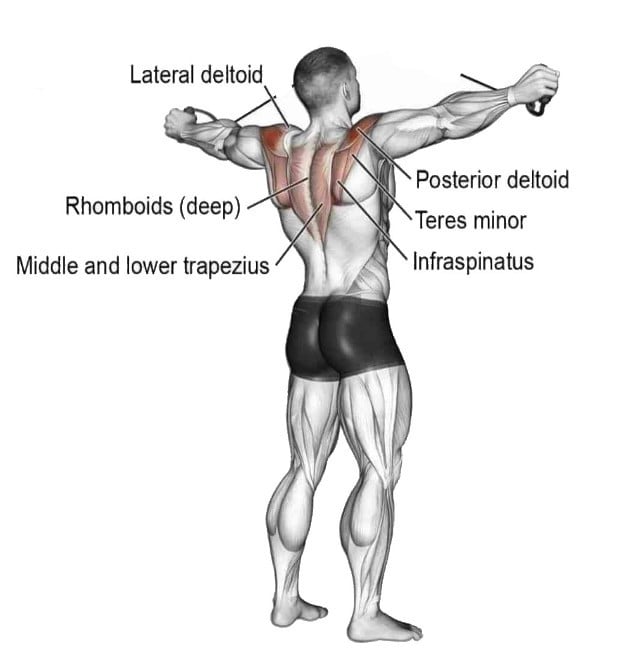
Benefits Of Reverse Cable Fly
Cable reverse fly exercises also help to:
- Targets and strengthens the rear deltoid muscles.
- Promotes balanced shoulder development.
- Improve posture by reducing the effects of rounded shoulders.
- Enhances shoulder stability and reduces the risk of injuries.
- Contributes to a more aesthetically pleasing upper body appearance.
- Benefits functional movements and athletic performance.
- Offers versatility for different fitness levels and goals.
- Build symmetry with the shoulder, preventing a “forward sloping” look
- Improve shoulder function, which is important because they help with movements like pulling, rowing, and throwing.
Want to take your gains to the next level? Discover your daily calorie needs with our free TDEE calculator
How To Do Standing Cable Reverse Fly
It can be used as a finisher in a shoulder or back workout. You can get better results by using lightweight so you can focus on proper form and technique.

Here’s a step-by-step guide on how to do it:
- Set the pulleys to the desired height, usually around chest level. Attach the D-handles to the cables. Check that both pulleys are the same height.
- Stand in the center of a cable apparatus. Position your feet shoulder-width apart for stability.
- Grab the left cable handle in your right hand and the right side handle in your left hand.
- Take a step back to create tension in the cable. Engage your core for stability.
- With your elbows slightly bent, pull your arms out to the sides in a controlled and deliberate manner. Squeeze your shoulder blades together as you do the move.
- Continue pulling your arms pull out and back as far as possible. Pause for a moment at the peak contraction, and feel the engagement in your rear deltoids.
- Slowly lower your arms back to the starting position.
- Aim for 10-15 repetitions per set.
Tips And Form For Reverse Cable Fly
- The posterior deltoid is best targeted with your torso upright, not leaning too far forward or back.
- Engage your core muscles for stability and support.
- Maintain a controlled and slow pace during both the outward and inward phases of the exercise.
- Keep your elbows slightly bent throughout the exercise. Avoid fully extending or locking out your elbows.
- Keep your elbows slightly higher than your wrists.
- Focus on squeezing your shoulder blades together at the peak of the movement to activate your rear deltoid muscles.
- It is important to avoid excessive swinging or using too much weight, as this can compromise form and effectiveness.
- Exhale as you pull your arms back, and inhale as you come back. Keep your breathing steady.
- To maximize the benefits of the exercise, it’s important to establish a strong mind-muscle connection.
- You should aim to complete 3-4 sets of 10-12 reps of the cable reverse fly.
- As you become more comfortable with the form, feel free to change your set and rep ranges to challenge yourself.
Set, Reps And Frequency
Here are some general guidelines for sets, reps, and frequency for the cable reverse fly exercise. Remember to listen to your body and adjust the training according to your capacity and requirements.
Beginner
- Sets: Start with 2-3 sets per workout.
- Reps: Perform 8-12 reps per set.
- Frequency: 1-2 times per week.
Intermediate
- Sets: Increase to 3-4 sets per workout
- Reps: Aim for 10-12 reps per set with a slightly heavier weight compared to the beginner level.
- Frequency: 2-3 times per week.
Advanced
- Sets: Perform 4-5 sets per workout
- Reps: Aim for 10-15 reps.
- Frequency: 2-3 times per week, allowing a day of rest between sessions.
Reverse Cable Fly Variations
Above, we dissected the traditional variation of the cable rear delt fly. This fly version is what is usually seen and is an excellent back and shoulder exercise in its own right.
Furthermore, there are several variations that you can do to achieve different muscle activation. While the primary function of the exercise is there, these fly variations can really feel like a new movement.
1. Bent Over Reverse Cable Fly
The bent-over reverse fly is a variation of the cable fly exercise that primarily targets the rear deltoids, upper back, and rhomboid muscles.
The exercise involves bending over at the waist and performing the reverse fly move, which enhances the engagement of the lower back and glutes.
Unlike dumbbell raises where the resistance varies during the lift, the cable pulley affords a uniform resistance throughout the motion.
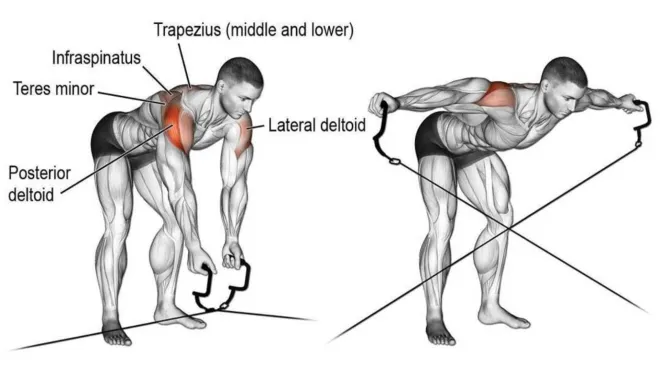
How To Do Bent Over Cable Reverse Fly
- Adjust the cable machine to low pulley and attach D-handles to the cables.
- Bend forward at the waist, maintaining a neutral spine and keeping your back flat. Hinge until your upper body is nearly parallel to the floor.
- Grab the handles attached to two low pulleys (left-side handle in right hand, right-side handle in left hand)
- Raise your hands outward and upward in an arc motion, similar to the regular reverse cable fly.
- Squeeze your shoulder blades together at the top of the movement, pause for a moment.
- Then slowly return to the starting position.
Tips
- Keep a flat back, engage your core, and avoid rounding your shoulders.
- Focus on the muscle contraction and maintain a slow and controlled tempo.
2. Seated Reverse Cable Fly
The Seated takes away the potential of using momentum and makes the movement more challenging.
The incline bench position allows for greater isolation and activation of the rear deltoid muscles, leading to enhanced development and strength.
This exercise targets such small muscles, that’s why it is usually performed with lightweight for high reps, such as 10-15 reps per set or more.
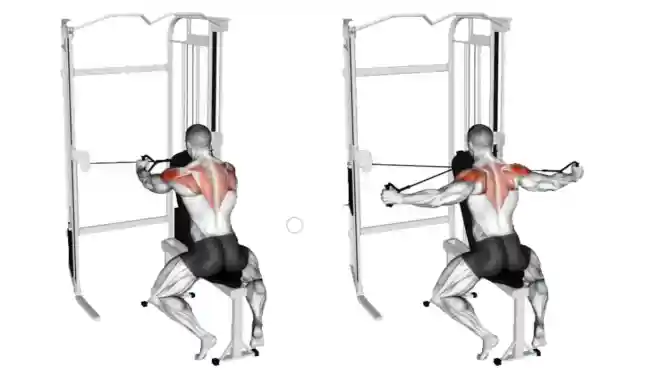
How To Do Seated Cable Reverse Fly
- Place an incline bench sideways midway between two cable stations.
- Set an incline bench to a comfortable angle, typically between 45 to 60 degrees.
- Sit with your chest against the backrest and your feet planted firmly on the ground.
- Grasp the D-handles attached to the cables with the opposite-side hand.
- Keep your arms slightly bent and pull the cables out to your sides.
- Slowly lower the cables back to the start, but don’t let the weight stack touch down at the bottom before beginning your next rep.
Tip
- Keep your chest against the bench and maintain a neutral spine.
- Set a bench at about 45-60 degrees inclined.
- Keep form strict to isolate the rear delts.
3. Single Arm Standing Reverse Cable Fly
The single-arm standing reverse cable fly is a unilateral variation of the reverse cable fly exercise, focusing on one arm at a time. Additionally, you should find that your mind-muscle connection is stronger during single arm exercise.
Doing the exercise with one arm at a time helps you find and fix any differences in strength or muscle size between your left and right sides. This helps your muscles to be more balanced and symmetrical.
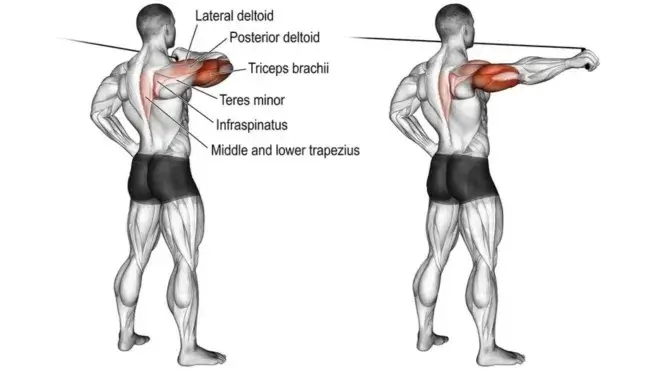
How To Do Single Arm Standing Reverse Cable Fly
- Adjust the cable machine to shoulder level and attach a single D-handle to the cable.
- Stand with your feet shoulder-width apart.
- Make sure that the left side of your body is facing the cable pulley, and then grab the rope or D-handle with your right hand.
- Exhale and extend your arm to the right, so your arm is straight.
- Inhale and slowly bring your arm back to the starting position.
- Repeat for the desired number of reps.
Tips
- It is best to use light to moderate weights to minimize joint stress and maintain good form.
- Keep your core engaged, maintain a neutral spine, and avoid any twisting or compensatory movements.
- To ensure balance and symmetry, perform an equal number of repetitions on each arm.
Cable Rear Delt Fly Alternatives
The cable reverse flys are a great shoulder and upper back exercise, but you don’t need to do them all the time. There are several alternatives you can use to keep your workouts productive and interesting:
Before we deep dive into the best reverse cable fly alternatives. We must remember, a good reverse fly alternative will be able to satisfy the following criteria:
- Activate the rear delt muscle groups, which is trained in the reverse cable fly.
- Isolate the muscle groups during execution.
- Train the rear delt muscle through a longer range of motion
1. Bent Over Dumbbell Lateral Raise
Dumbbell Bent Over raises is one of the best alternate of cable reverse fly. It is an excellent exercise to focus specifically on the rear deltoid muscles.
Thus, the exercise hit specifically the rear delt head by isolating it better than any other shoulder exercise. This exercise can be performed in both a standing and a seated position. Prefer the seated version as it calls for strict movement.
2. Dumbbell Rear Delt Row
The rear deltoid row exercise is simple and effective, that is used to target your lats and rear deltoids. This exercise is very similar to a basic one-arm dumbbell row for the lats, except with a couple of important modifications.
3. Seated Rear Delt Fly Machine
The Rear Deltoid Machine Fly is designed to specifically target the rear deltoid muscles in a controlled and supported seated position. It is suitable for beginners or individuals with limited stability.
4. Face Pull
Face pull is a cable machine exercise that primarily targets the rear deltoid and to a lesser degree also targets the biceps, triceps, and traps.
This exercise prevents muscular imbalance and builds overall shoulder strength.
FAQ
Is The Cable Rear Delt Fly Good?
The cable rear delt fly is perhaps the best isolation exercise for your posterior deltoid and back. You need to be doing them.
What Muscle Does The Revers Fly Work?
The reverse fly works your upper back muscles and shoulder muscles, particularly the rear deltoids, on the backside of your shoulders.
Is it necessary to use heavy weights for the reverse cable fly?
It is not necessary to use heavy weights, focus on using a weight that allows you to perform the exercise with controlled and correct technique.
The weight used for the reverse cable fly should be challenging enough to fatigue the muscles within the desired repetition range, while maintaining proper form.
Is reverse fly push or pull?
The reverse fly is a pulling exercise. In this exercise, you are pulling the weights or cables away from your body. It’s pulling actions, making it a beneficial exercise for the posterior shoulder and upper back.
Why is reverse fly so hard?
The reverse fly exercise can be challenging due to the weaker rear deltoid muscles, limited range of motion in the shoulders, lack of posterior chain strength, the need for a strong mind-muscle connection, and the requirement for stability and balance.
Takeaways
Now that you know a few variations for your reverse cable fly, try each one out at the gym to get the full benefit. Don’t limit yourself to variations on this exercise, either. There are several alternatives you can use to keep your workouts productive and interesting.
The cable reverse fly is the perfect exercise, as it uses a light load and requires a tremendous mind-muscle connection. Cable rear delt flyes are a must for serious lifters.
Always look for new and interesting ways to perform all your staple movements so that you never get stuck waiting at the gym, never grow bored, and always keep growing.
Rear Delt Cable Exercises for Bigger and Stronger Shoulder

Manish brings over 10 years of hands-on experience in weight lifting and fat loss to fitness coaching. He specializes in gym-based training and has a lot of knowledge about exercise, lifting technique, biomechanics, and more.
Through “Fit Life Regime,” he generously shares the insights he’s gained over a decade in the field. His goal is to equip others with the knowledge to start their own fitness journey.
